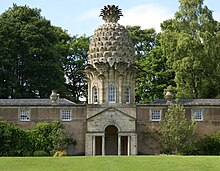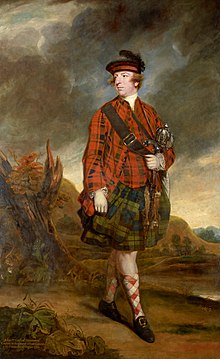John Murray, 4th Earl of Dunmore
John Murray, 4th Earl of Dunmore (* 1730 - 25 February 1809 in Ramsgate , Kent ), was British Governor of the Province of New York from 1770 to 1771 and of the colony of Virginia from September 25, 1771 to New Year's Eve 1776 .
He came from the French line of the Stuarts . His parents were William Murray, 3rd Earl of Dunmore , and Catherine Murray. In 1756 he inherited the dignity of Earls from his father and sat 1761-1774 and 1776-1790 as one of the 16 Scottish representatives ( Representative Peer ) in the House of Lords . In 1770/1 he was governor of the province of New York and was then promoted to governor of the colony of Virginia from 1771 to 1776, the richest and largest British province in North America. During this time he led a series of campaigns against the Indians, the Shawnee and Mingo , in 1774 , who fought against settlers in the Ohio area, especially from Virginia. Above all, however, he was pursuing the goal of underlining the claims of Virginia in the west (in Ohio ) against Pennsylvania. While the militia Colonel Andrew Lewis defeated the Shawnee who were on the warpath on the Kanawha River , they followed Murray across the Ohio with a second troop to their tent camp and was finally able to conclude a peace agreement with the Indians.
Murray was initially considered a hero and was initially just as popular in Virginia as it was in New York before, but by 1773 Murray had almost constant conflicts with the General Assembly of Virginia, especially when he dissolved the legislature in 1773 and 1774 (for aiding people who did not loyal to the Kingdom of Great Britain ) and in 1774 removed powder from the magazines of the Williamsburg militia. On June 8, 1775, after threats against his life, he left the capital Williamsburg and retired to his hunting estate at Porto Bello. At the beginning of the Revolution he found refuge on the British warship HMS Fowey in the River York. He tried to put down the uprisings and was initially successful at the Battle of Kemp's Landing , but his overconfidence (and an American double agent) led to his defeat at the Battle of Great Bridge on December 9, 1775, after which he moved to New York withdrew. Murray returned to Great Britain in July 1776 after realizing the hopelessness of returning to his post as governor. His proclamation of November 7, 1775 is well known, in which he promised freedom to African slaves who joined the army (the Royal Ethiopian Regiment ) on the side of the Loyalists . This was the first major liberation of slaves in North America, but after his resignation he sold them back into slavery .
From 1787 to 1796 he was governor of the Bahamas . After his death in 1809, his eldest son George Murray inherited the title.
In 1796 he was elected a member ( Fellow ) of the Royal Society of Edinburgh . Dunmore County, Virginia, named after him in 1772, was renamed Shenandoah County during the Revolution . His Porto Bello hunting estate still exists in Camp Peary , York County and is a listed building, but is not open to the public. In Scotland, the Dunmore Pineapple summer pavilion built on his estate near Airth in the Falkirk Council Area in 1761 , which belongs to the National Trust for Scotland , is used as a holiday home and whose gardens are generally accessible, commemorates him . It is in the shape of a pineapple, and pineapples that he brought back from the Bahamas were also grown there.

Marriage and children
He married on February 21, 1759 Lady Charlotte Stewart (before 1744-1818), the daughter of Alexander Stewart, 6th Earl of Galloway . They had eight children:
- Lady Catherine Murray (1760–1783) ⚭ Hon. Edward Bouverie, son of the 1st Earl of Radnor
- George Murray, 5th Earl of Dunmore (1762–1836)
- Hon. William Murray (1763–1773)
- Lt.-Col. Hon. Alexander Murray (1764–1842)
- Hon. John Murray (1766-1824)
- Lady Augusta Murray (1768–1830) ⚭ Augustus Frederick, Duke of Sussex (she was the daughter-in-law of King George III )
- Lady Susan Murray (1767–1826) ⚭ Joseph Tharp
- Hon. Leveson Granville Keith Murray (1770–1835)
Web links
- Biography at bookrags.com
- John Murray, 4th Earl of Dunmore on thepeerage.com , accessed September 10, 2016.
- John Murray, 4th Earl of Dunmore in the database of Find a Grave (English)
Individual evidence
- ^ Fellows Directory. Biographical Index: Former RSE Fellows 1783–2002. (PDF file) Royal Society of Edinburgh, accessed March 23, 2020 .
| predecessor | Office | successor |
|---|---|---|
| William Murray |
Earl of Dunmore 1756-1809 |
George Murray |
| personal data | |
|---|---|
| SURNAME | Murray, John, 4th Earl of Dunmore |
| BRIEF DESCRIPTION | British governor |
| DATE OF BIRTH | 1730 |
| DATE OF DEATH | February 25, 1809 |
| Place of death | Ramsgate |

